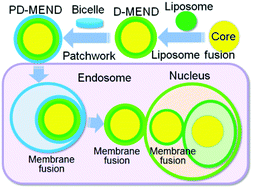Tri-membrane nanoparticles produced by combining liposome fusion and a novel patchwork of bicelles to overcome endosomal and nuclear membrane barriers to cargo delivery†
Abstract
Membrane fusion is a rational strategy for crossing intracellular membranes that present barriers to liposomal nanocarrier-mediated delivery of plasmid DNA into the nucleus of non-dividing cells, such as dendritic cells. Based on this strategy, we previously developed nanocarriers consisting of a nucleic acid core particle coated with four lipid membranes [Akita, et al., Biomaterials, 2009, 30, 2940–2949]. However, including the endosomal membrane and two nuclear membranes, cells possess three intracellular membranous barriers. Thus, after entering the nucleus, nanoparticles coated with four membranes would still have one lipid membrane remaining, and could impede cargo delivery. Until now, coating a core particle with an odd number of lipid membranes was challenging. To produce nanocarriers with an odd number of lipid membranes, we developed a novel coating method involving lipid nano-discs, also known as bicelles, as a material for packaging DNA in a carrier with an odd number of lipid membranes. In this procedure, bicelles fuse to form an outer coating that resembles a patchwork quilt, which allows the preparation of nanoparticles coated with only three lipid membranes. Moreover, the transfection activity of dendritic cells with these three-membrane nanoparticles was higher than that for nanoparticles coated with four lipid membranes. In summary, we developed novel nanoparticles coated with an odd number of lipid membranes using the novel “patchwork-packaging method” to deliver plasmid DNA into the nucleus via membrane fusion.


 Please wait while we load your content...
Please wait while we load your content...